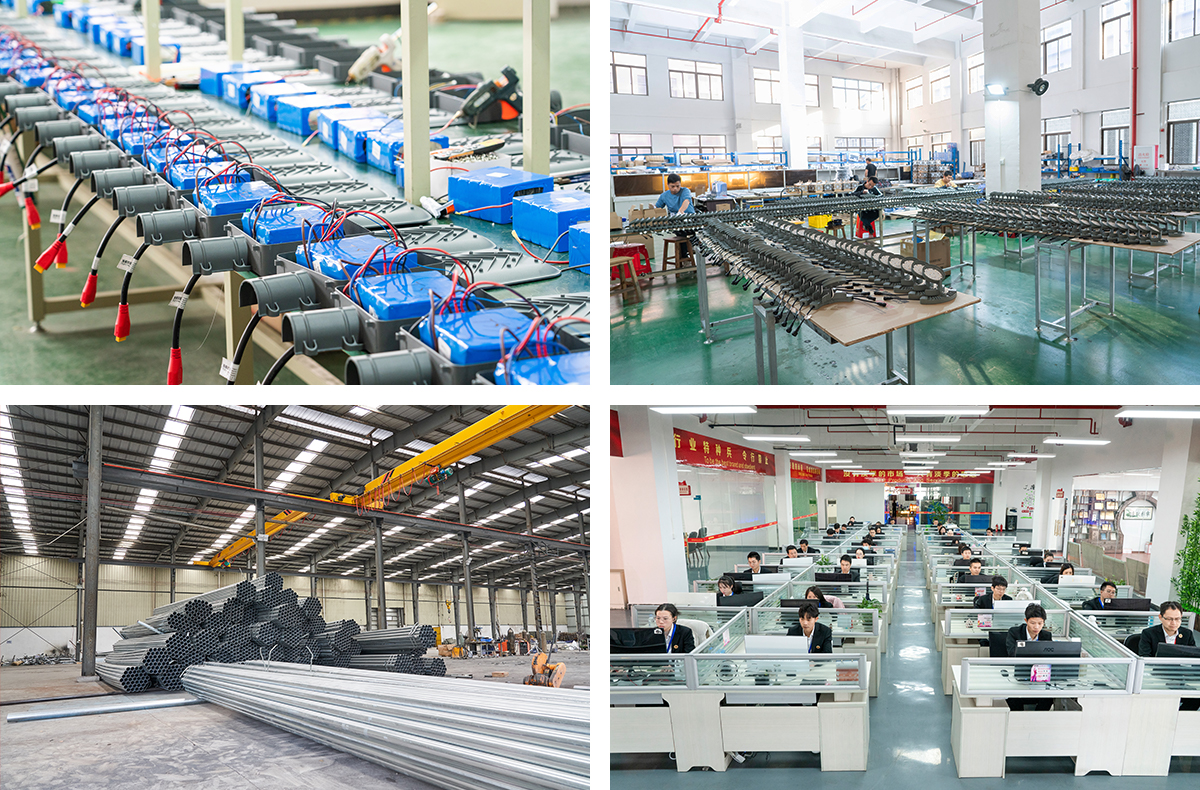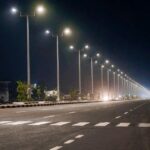As a manufacturer, we have faced various challenges on our solar street light assembly lines and have had to innovate to remain competitive and on top of the game. This phenomenon is nothing new: as customer demands evolve, so must we. In this fast-paced world of renewable energy, staying stagnant is not an option. Now, let’s explore the various strategies we’ve adopted to tackle the challenges in our assembly lines and share insightful insights into how you can maintain your competitive edge.

Solar street light assembly factory
Challenges & Solutions In Solar Street Light Assembly Lines
What are some of the challenges you are sure to meet along the way? We’ll also share appropriate solutions for these challenges.
Component Integration
Solar streetlights have various components that work together seamlessly. Combining these different elements can often pause an integration challenge. One such issue is ensuring compatibility among different components sourced from separate suppliers. Mismatched specifications or designs can lead to malfunctions or even complete system failure of your solar street light assembly line. To address this challenge, establish stringent quality control measures through meticulous testing of components before integration to verify compatibility. Additionally, collaborate closely with your suppliers and conduct regular audits to maintain consistency in component quality.
Another challenge is the physical integration of all these components within the street light structure. You often have limited space to work with, and specific design requirements necessitate precise placement and assembly techniques. There are two easy fixes for this challenge. First, you can use modular design principles to facilitate easier integration by allowing standardized components to fit seamlessly within the assembly. Additionally, you can standardize the manufacturing process in your solar street light assembly line. Standardization reduces production time and minimizes errors during the assembly process.
Quality Control
You often want to meet the quality expectations of your customers. You can only achieve this goal by having a vigorous quality control mechanism on your solar street light assembly line. One major challenge in quality control is the variability in the performance of the different components. Test the solar panels’ efficiency in converting sunlight into usable electricity. Similarly, test the batteries’ reliability and durability in energy storage and distribution. Precisely calibrate any sensors and the controller for efficient operation. Any slight variations in manufacturing can lead to significant differences in performance. To be proactive, implement rigorous testing protocols at multiple stages of production. Your tests should include pre-assembly testing of individual components and post-assembly testing of the final product.
You should also set up a robust quality management system (QMS) to improve quality control. A QMS provides a framework for consistently producing high-quality products by standardizing processes, documenting procedures, and regularly reviewing and improving production methods. Certifications like ISO 9001 demonstrate your commitment to quality. Additionally, a QMS can help you choose and maintain a skilled workforce. Such a workforce understands the importance of quality at every stage of the assembly process.
Supply Chain Management
The COVID-19 pandemic highlighted the critical importance of a stable supply chain. A key challenge in supply lies in the sourcing and availability of components, such as photovoltaic panels, batteries, and LED lights. These components often come from various suppliers around the globe, leading to potential delays and disruptions. Geopolitical tensions, trade restrictions, and logistical hurdles can further exacerbate such issues. Establishing long-term partnerships and agreements can ensure a more stable supply of critical components. Additionally, diversify the supplier base to reduce dependency on any single source.
Another challenge is maintaining consistent quality across different batches of components. Variations in input quality can lead to inconsistencies in the final product. To mitigate this issue, precisely coordinate the various production stages. Ensuring each stage flows harmoniously can yield incremental advantages. Enhance and insist on proper communication between the production teams to improve morale and output. Regular audits and inspections can also help identify and correct issues early on.
Energy Efficiency
When you want to improve energy efficiency, you should consider the components used in the street light. High-efficiency photovoltaic cells, batteries, and LED lights are essential to reduce energy losses. For instance, you can use monocrystalline panels for their high-efficiency rates instead of polycrystalline panels. Similarly, choose lithium-ion batteries instead of traditional battery systems for their energy storage capabilities and longer life cycles. Also, reserve substantial funds for research and development. R&D can expose you to new materials and technologies that can enhance the performance of your solar streetlights. Such innovative technologies include perovskite for PV cells, solid-state batteries, and IoT integration. Understanding and experimenting with these technologies could transform the fundamental working principles of solar streetlights.
We often overlook the significance of optimizing energy efficiency within the solar street light assembly line, focusing solely on the end product. Identifying and addressing inefficiencies in the production line is crucial. Some production stages, like welding, consume substantial electrical energy. You can use innovative techniques like pulse welding to avoid huge electrical bills. Additionally, optimize the design and layout of your assembly line. Adopt concepts like the Lean manufacturing principle to streamline the production processes.
Cost Efficiency
Cost is always a tricky factor to contend with in the manufacturing process. The goal is to minimize expenses while maintaining a high-quality product. You need a multi-faced approach to achieve this balance in your solar street light assembly line. Firstly, you need to consider streamlining the manufacturing process. Automation could be a good idea to reduce labor costs and improve throughput. Automation can significantly improve productivity and lower per-unit costs by increasing the speed and accuracy of assembly tasks.
Next, you should optimize the solar streetlight components. Your engineering team can focus on creating designs that utilize cost-effective materials without compromising on durability or functionality. This testing could involve extensive research into alternative materials that offer similar performance characteristics but at lower costs. Additionally, simplify the design where possible to reduce manufacturing complexity and thus lower production expenses.
Scalability
We all dream of outgrowing our current solar street light assembly line due to increased demand and growth in profit margins. This dream could become troublesome if you cannot efficiently handle increasing production demands without compromises. What should you do to be ready? Firstly, consider how to optimize the production line layout and workflow. A non-scalable assembly line may have inefficient layouts, bottlenecks, or manual processes that hinder the smooth flow of materials and components. To address this task, you can rearrange workstations for better flow and automate repetitive tasks.
Secondly, consider sourcing components in large quantities while maintaining quality standards. Scaling up your solar street light assembly line will need additional and constant supply of materials. Implement a robust supply chain management system to ensure a steady flow of high-quality materials at competitive prices. Additionally, reflect on your workforce. Ensure your workforce is adequately trained, motivated, and equipped with the necessary skills as production scales up. Invest in employee training programs, cross-training initiatives, and knowledge transfer mechanisms.
Conclusion
There is no way around optimizing your solar street light assembly line. These insights we’ve shared are just the tip of the iceberg. The challenges discussed here are just the beginning of what you may face in your manufacturing journey. Contact us if you have any hurdle you feel we’ve not covered.


















